- News
- Reviews
- Bikes
- Components
- Bar tape & grips
- Bottom brackets
- Brake & gear cables
- Brake & STI levers
- Brake pads & spares
- Brakes
- Cassettes & freewheels
- Chains
- Chainsets & chainrings
- Derailleurs - front
- Derailleurs - rear
- Forks
- Gear levers & shifters
- Groupsets
- Handlebars & extensions
- Headsets
- Hubs
- Inner tubes
- Pedals
- Quick releases & skewers
- Saddles
- Seatposts
- Stems
- Wheels
- Tyres
- Tubeless valves
- Accessories
- Accessories - misc
- Computer mounts
- Bags
- Bar ends
- Bike bags & cases
- Bottle cages
- Bottles
- Cameras
- Car racks
- Child seats
- Computers
- Glasses
- GPS units
- Helmets
- Lights - front
- Lights - rear
- Lights - sets
- Locks
- Mirrors
- Mudguards
- Racks
- Pumps & CO2 inflators
- Puncture kits
- Reflectives
- Smart watches
- Stands and racks
- Trailers
- Clothing
- Health, fitness and nutrition
- Tools and workshop
- Miscellaneous
- Buyers Guides
- Features
- Forum
- Recommends
- Podcast
feature
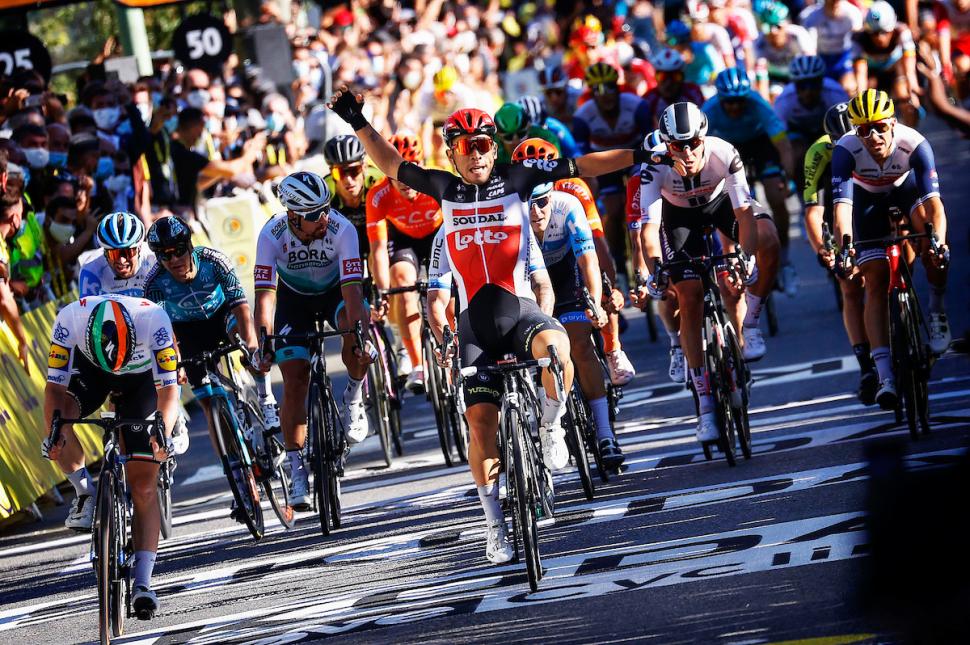 Caleb Ewan wins 2020 Tour de France Stage 3 © CorVos/SWpix.com_
Caleb Ewan wins 2020 Tour de France Stage 3 © CorVos/SWpix.com_The inner workings of a Tour de France sprint lead-out - how the fastest get to the finish line first
Watching a sprint stage in the Tour de France can be incredibly confusing if you’re not sure what you’re looking for. So why do they go so fast when there’s still 10km to go and why don’t you ever see the sprinter until the final seconds of the stage? Wait a minute, what’s the yellow jersey doing so close to the front? Do they sprint too?
Given that we can’t actually go to the Tour de France this year to take close-up photos of components and annoy the riders until they answer our questions, we thought we’d take a step back and try to answer some of the questions that often get asked when the Tour de France is on.
Today we’ll focus on the chaotic world of the sprint stages and before we start, you’ll need to wake up from that nap you haven’t been taking after the commentator starting talking about another chateau. The 200km stage has so far been a bit of a snooze fest. Don’t worry, even hardened cycling fans have muted the TV and gone back to doing their day job. The break consists of three brave (foolish) Frenchmen who are riding three minutes ahead of the peloton, who are relaxing, safe in the knowledge that everything is under control. Not much will be happening until around 50km to go, so we can pause to answer another question that we usually get asked around this point in the stage.
Why have they let them get away?
The casual viewer will see three riders with a three-minute gap and wonder why the peloton let them ride off. A small breakaway will form early in the stage primarily for sponsorship reasons. The riders out front get a lot of time on TV and the companies with logos on their kit will love four hours of world-wide coverage. There is also a tiny chance that the break will make it and cling on to fight for the stage win. This rarely happens though, so the peloton, with so many riders whos job it is to make sure the stage ends in a sprint, will always be confident of reeling in the escape.
Anyway, we’ve just headed under the 50km to go banner and the peloton has just started to bring the gap down. This is where things get interesting.
The breakdown - From 50km to 10km to go
With the race heading towards a sprint finish, the key sprinters will place one or two teammates up at the front of the peloton to steadily ramp up the pace. They do this very gradually as they’ll have the best part of 40km to ride on the front. At around 50kph, that takes quite a bit of effort and they don’t want to burn their matches too early. Leaving the breakaway up the road a little helps the sprinter’s teams to control the peloton. There is less chance of other riders trying to escape if they can see that the current breakaway is already doomed.
Generally, you’ll find between three and six riders from different team riding at the front during the early stages of this crucial period and it can look a little messy. But these riders give us a clue as to which sprinters feel confident about their chances in the finale.
As the kilometres tick down past 30km to go, you’ll see lines of riders forming, with each team getting themselves into order. Finally, we have a bit more structure at the front of the peloton but things won’t kick off just yet. The riders at the front of each line won’t outpace the other riders. They are simply holding their position at the front and don’t need to push the pace just yet.
Problems can start to arise when you consider who wants to be at the front. Obviously, each sprinter wants their respective lead-out trains in position at the front, but to help avoid crashes and the time losses that they bring, the riders aiming for the general classification will also want to be towards the front. This is where space starts to get very tight and the crashes can be massive.
Inside the final 10km
We’ve crossed a critical point now, where the throttle gets ever so slightly twisted as the fight to be at the front becomes ever fiercer. Any road furniture like roundabouts or sharp corners become mini finish lines in their own right with teams fighting to be first through. Making the effort to get through a tight spot first is far easier than getting back to the front should there be a split in the long line of riders sprinting out of the tight spot.
Riders on the front of the peloton are doing shorter, faster turns now as we fly through the closing kilometres. They want to keep the pace as high as possible, firstly to keep their leader towards the front, but also to deter any sneaky attacks.
The breakaway tried hard but they’ve been caught as we get to the final five kilometres and the GC riders are still present at the front. Egan Bernal has Luke Rowe, Primoz Roglic has Wout van Aert to help protect them as the riders start to bump handlebars more frequently and the elbows start flying.
Why don’t they just ride off now?
Before the sprint launches, let’s address one question that seems to get asked a lot. If the sprinters are so much faster than everyone else, why don’t they just go now? They’d surely win by miles. By this point, the peloton is travelling at around 60kph and the power (or effort) required to ride faster goes up exponentially, not in a linear fashion. To jump away from the charging peloton at this speed would require everything that a rider has and is an effort that the best can only sustain for around 20 seconds. This is also why as we get closer to the finish line and the speed increases, the teammates at the front are taking ever shorter turns. They are themselves, effectively sprinting, with the draft they create allowing their teammates to save their big effort for closer to the line.
Look out for freelancers
As we hit 4km to go, it is also a great time to spot the sprinter that is having to forge their own path through the chaos. Cavendish was great at surfing the wheels when he needed to and Caleb Ewan has used this to devastating effect in this year’s race.
Riders on teams aiming to support a GC rider like Jumbo Visma (the teammates will mostly be climbers) and smaller teams like AG2R, B&B Hotels and NTT will often have to hitch a ride on a rival team’s lead-out train, piggybacking on their work. This tactic allows a rider to choose the strongest lead-out train, but it does require a fair bit of fighting as there are lots of riders doing the same thing.
Au revoir, skinny people
With three kilometres to race, the pace is now reaching its peak but there is about to be a little more room to manoeuvre for the sprinters as the GC riders fade back through the bunch, safe in the knowledge that should there be a crash, they won’t lose time in the overall race.
Crunch time
Usually, one of the sprinter’s teams will have nailed their timing and, having saved a few riders for the final two kilometres, will become the dominant force at the front of the race.
Each rider that hits the front now will be expected to start their turn fast and end it even faster. All the while, the sprinters wait, sheltering from the wind to save energy and watching everyone for the first sign of their rivals launching.
The lead-out trains are down to the final one or maybe two riders and the red kite signalling the final kilometre shot by in a blur. Now, the lead-out rider is looking to launch their effort, taking the pace to crazy speeds with the aim to drop their sprinter off with around 300-150m until the line.
This is where a sprinter really wows the viewers. Able to keep a cool head at close to 70kph and pick gaps that you wouldn’t walk through, they can jump past the lead-out riders and any sprinters that have launched their effort too early to hit their maximum speed with just meters until the line. A quick bike throw settles things and the 200km stage has been won by a mere 50mm, the depth of a carbon rim.
All that’s left to do is avoid crashing into the bank of photographers as you celebrate no-handed, then await your teammates who need a big thanks. You might have to wait to see some of them at dinner as it's off to the podium for you while they’re still rolling gently to the finish line, having been dropped after their effort earlier in the day.
Latest Comments
- mitsky 35 min 52 sec ago
Is it any wonder that drink driving is still a problem when the police do nothing even with clear evidence like this: https://youtu.be/hw071PAofHQ
- Rendel Harris 42 min 22 sec ago
Such as, for example, saying: "It’s made from two types of fabric: super-loud yellow (orange is also available as a colour option, as is pink in...
- Mr Blackbird 47 min 22 sec ago
Possibly, but I think there will still be a time delay between receiving a warning and looking and the brain processing the image.I guess cycling...
- chrisonabike 2 hours 21 min ago
Indeed - but again these are perhaps questions we should keep asking. Even if the immediate answer is "well we are where we are" or "how on earth...
- Surreyrider 3 hours 15 min ago
Specialized aren't that American. Merida owns something like 49%.
- wtjs 4 hours 9 min ago
Then smash bad driving behaviour very hard...
- David9694 8 hours 46 min ago
Calls for Oxfordshire transport chief to resign blocked...

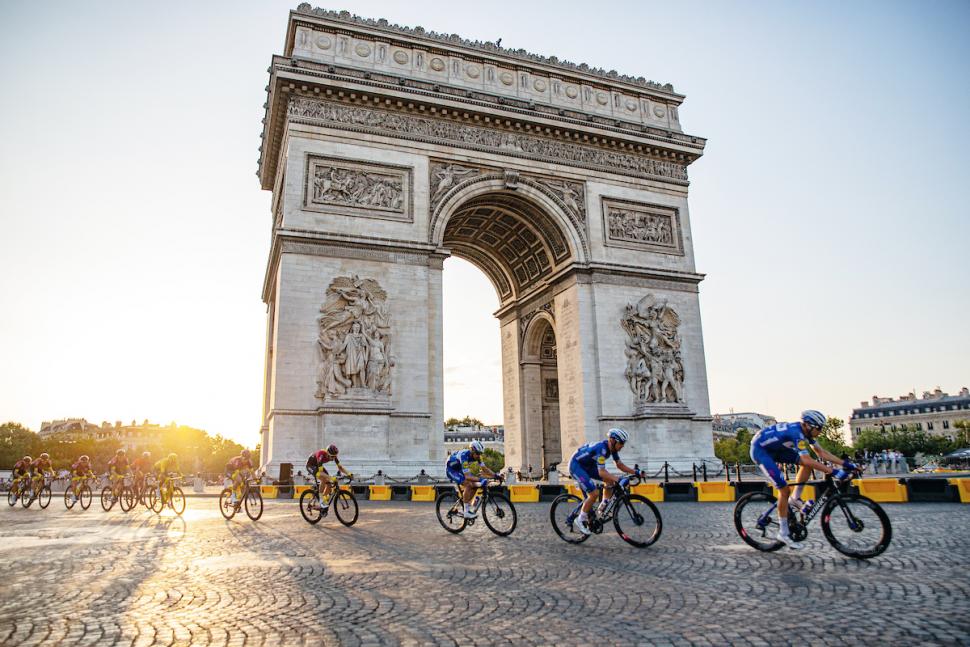
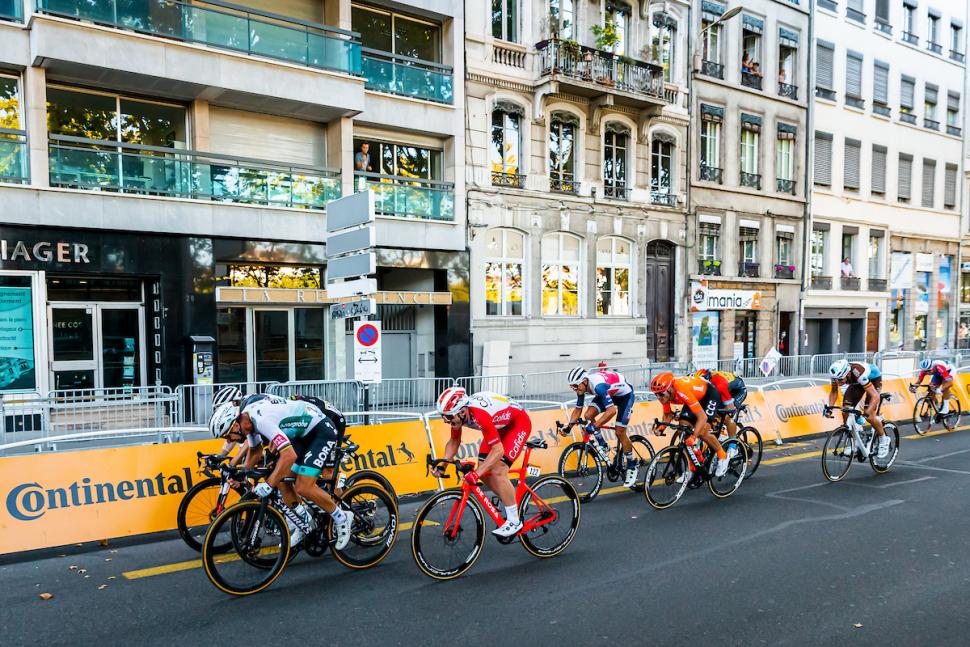
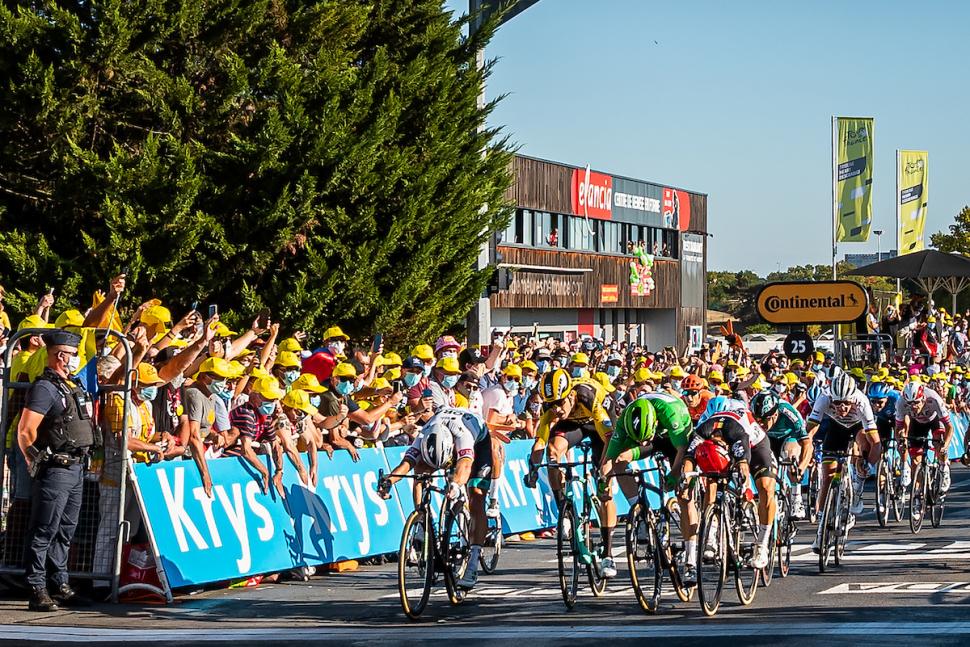
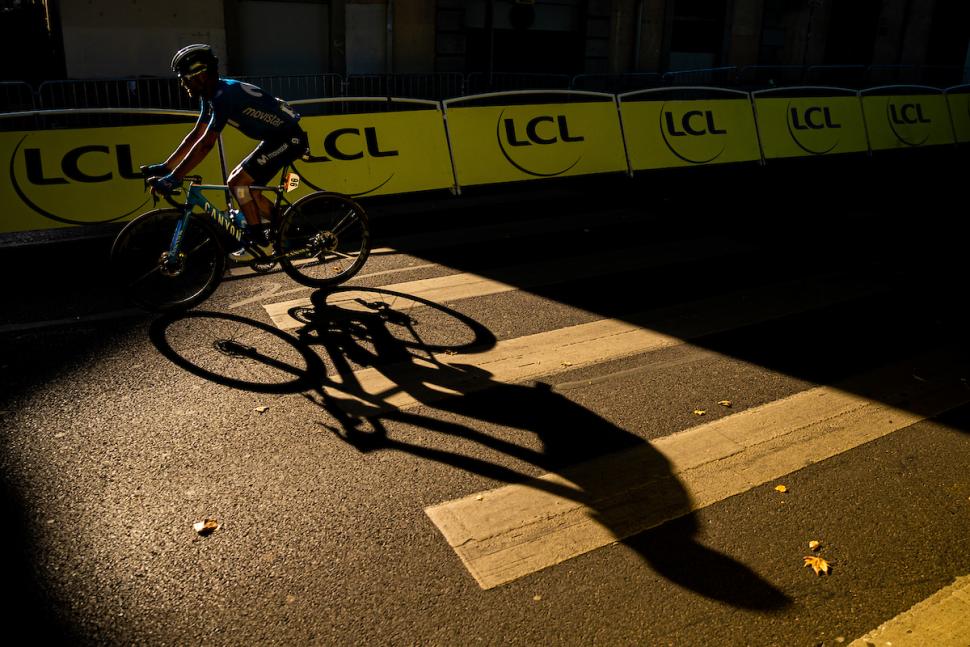
Add new comment
4 comments
Good stuff.
I'd like an equivalent piece on the mountains- during stage 15 the commentators were all obviously purring about Jumbo-Visma's team dominance.
What I don't quite get though, is the extent to which that really matters. Pogacar was able to sit on tier wheels and take the benefit of their team effort and win the stage.
If he had attacked earlier, to what extent would it really have assisted Roglich to have had 2 team members with, in terms of chasin Pogacar? Is there any significant drafting effect at climbing speeds, so that there is less wattage if you are following a team mate? Or is there a psychological benefit of having your mates there lookiing strong? or is all phooey and actually all that matters once you are on the final climb is the strength of your leader?
Yes that's a good idea, I'd like to see that article too.
My understanding is that 1) there is some drafting effect even on hills and at the power the pros hit it is enough to make a difference 2) having teammates means they can expand more effort, cover attacks and chase people down - in your scenario if Pogacar attacked early he still has to get to the end of the stage, but only one of the three JV riders does (Roglic), the other two can burn matches keeping the pace high, chasing him down or pulling Roglic up to him - Pogacar would have to be strong enough to ride away from all three. Of course the leader has to be strong enough in the end but having teammates to help makes a difference.
Fantastic read, great insight
Im liking these explanation thingies - keep em coming.